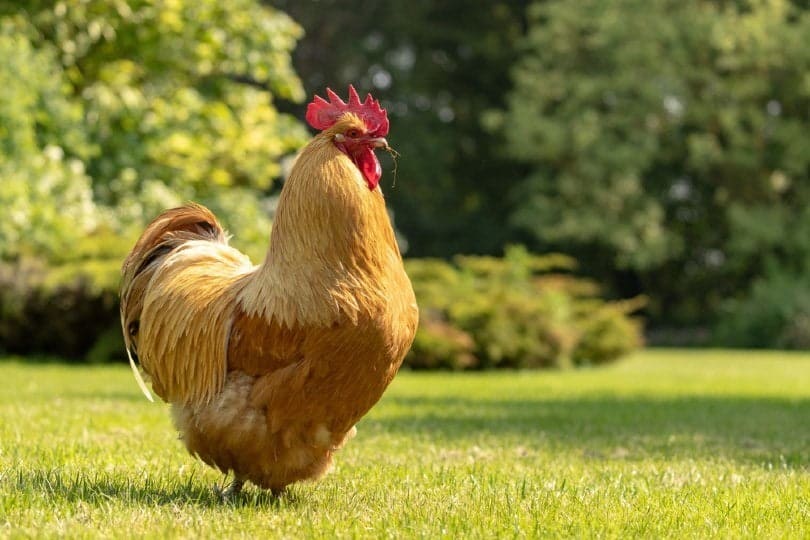Due to recent global events, people are starting to think about sustainability more than ever. Self-sufficiency is on the rise, and many are considering ways to start supplying their own food. One excellent way to provide your family with food is by raising chickens. A healthy hen can supply several eggs every week for many years. Additionally, you can harvest the chickens for meat, keeping your family well-fed, regardless of what events transpire in the future.
If you’re new to chickens, you might be surprised to realize that there are dozens of different breeds of chickens to choose from. Each of these birds has its own unique traits that make them more or less suitable for any given situation. Some are great egg layers. Others grow quickly to produce lots of meat. Whatever you’re looking for in a flock, you’re sure to find it in one of these types of chicken breeds.
There are hundreds of chicken breeds to choose from, and each has its own benefits. From the friendliness of the Sussex to the egg-laying prowess of the Australorp, you will not struggle to find a breed that is right for you in our list of the top 22 chicken breeds below.

The Top 22 Chicken Breeds
1. Araucana Chicken
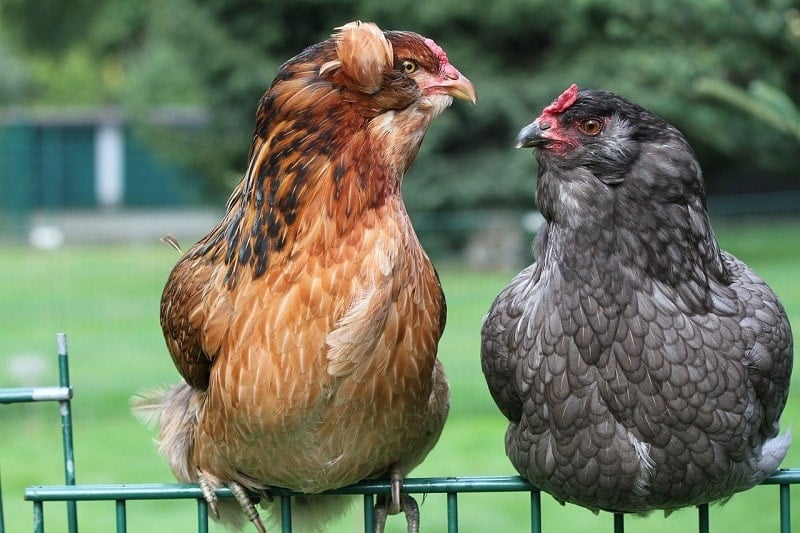
Weight: 4 – 5 lbs.
Appearance: The Araucana has no tail, no beard, and no muff but may have ear tufts. Available in various colors, they have puffed out cheeks.
Temperament: Some claim the Araucana to be the friendliest breed. Others say the opposite. Ensure regular handling as a chick for the best temperament.
Egg Production: The Araucana lays beautiful blue eggs and produces between 150 and 200 eggs a year. She won’t usually lay in winter.
2. Barred Plymouth Rock Chickens
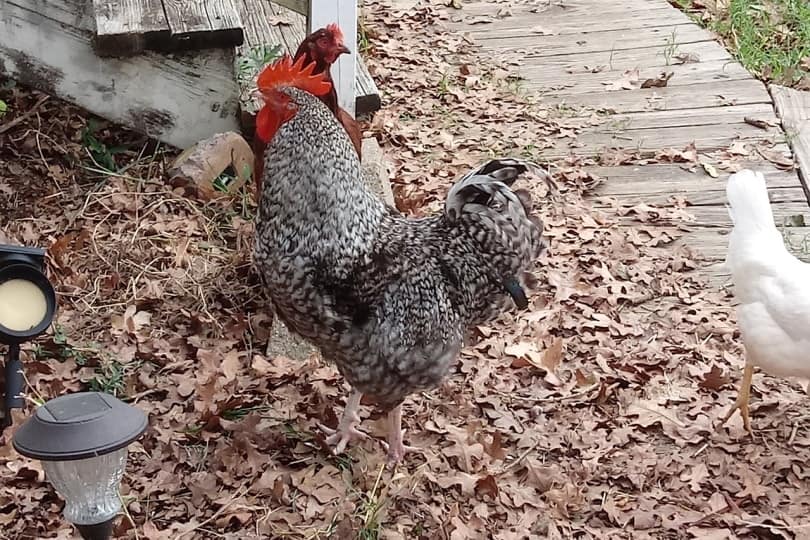
Weight: 7 – 10 lbs.
Appearance: The Barred Plymouth Rock is a large chicken with a triangular body. Color can vary, but the Barred Rock has black and white barred feathers.
Temperament: Commonly described as being calm and mellow birds, Barred Rock chickens get along with everybody.
Egg Production: The Barred Rock lays up to 280 large eggs a year, including during winter.
3. Rhode Island Red Chicken

Weight: 6 – 9 lbs.
Appearance: With a long rectangular body, the Rhode Island Red has orange eyes, yellow feet, and dark red bodies.
Temperament: Hardy animals, the Rhode Island Red is a good bird for inexperienced breeders because they can handle questionable conditions and an imperfect diet.
Egg Production: Expect between 200 and 250 eggs a year, with fewer in winter.
4. ISA Brown Chicken
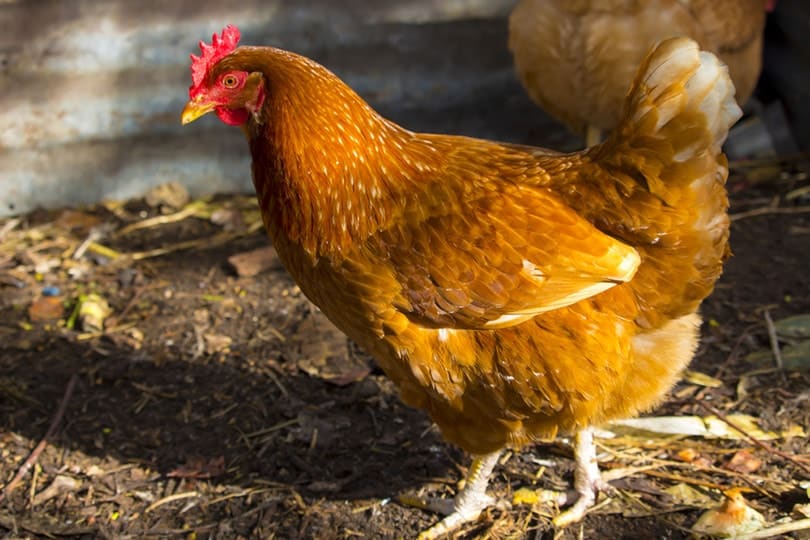
Weight: 4 – 7 lbs.
Appearance: This medium sized chicken has a brown, rectangular body with some white feathers in the tail. They can be quite plump.
Temperament: Docile, friendly, and sweet mannered: a good all-round choice.
Egg Production: Prolific layers, yielding up to 300 or more eggs a year.
5. Australorp Chicken

Weight: 6 – 11 lbs.
Appearance: This medium to large breed has black feathers, although blue and white varieties exist. It should be upright with a tall tail.
Temperament: Shy initially, the Australorp will follow you around the yard and will appreciate edible treats.
Egg Production: The breed lays up to 250 eggs a year. The eggs are light brown in color and medium in size.
6. Maran Chickens
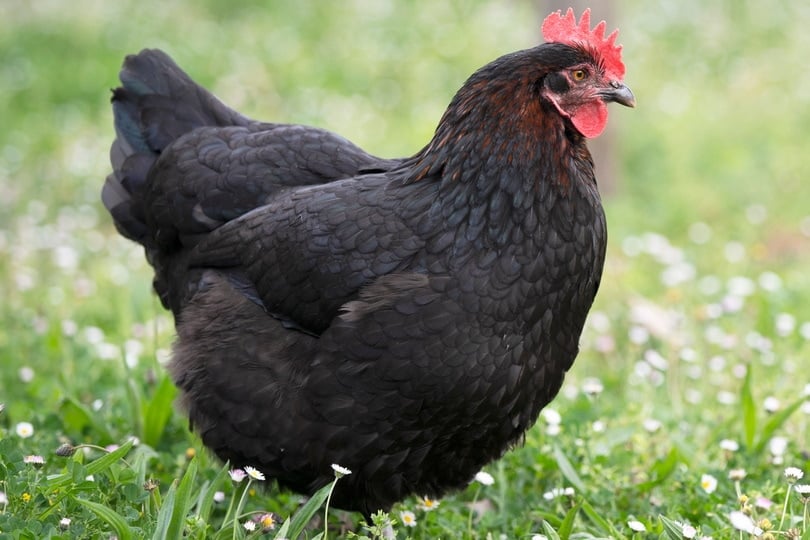
Weight: 6 – 10 lbs.
Appearance: Many varieties exist including the black-tailed red and the Rooster, both of which are named according to their physical appearance.
Temperament: Hardy animals that will thrive in any conditions, the Maran is a docile and relatively quiet breed.
Egg Production: 150 Dark brown eggs a year, with some varieties laying chocolate color eggs.
7. Buff Orpington Chicken
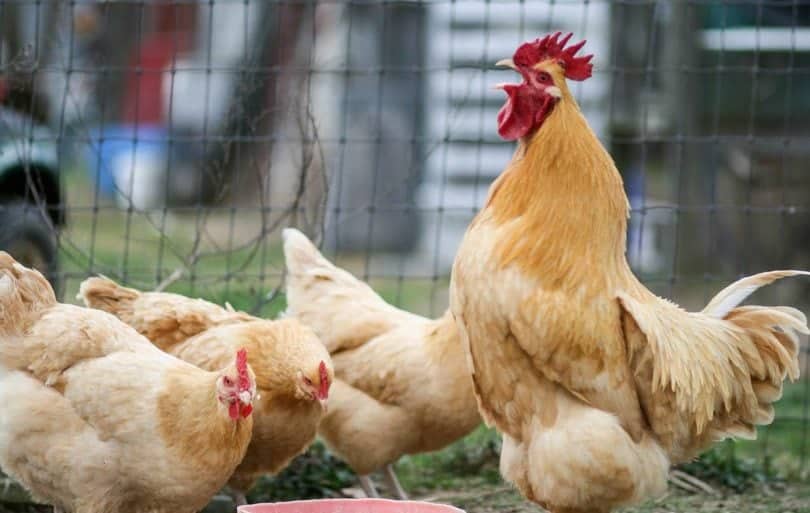
Weight: 7 – 10 lbs.
Appearance: Fluffy feathers, low stance, and a broad body, the Buff Orpington is the most common color of the Orpington breed.
Temperament: They are gentle giants and enjoy a little attention from their humans. Suitable for schools and families, too.
Egg Production: Orpingtons lay up to 280 large, brown eggs, every year.
8. Barnevelder Chickens
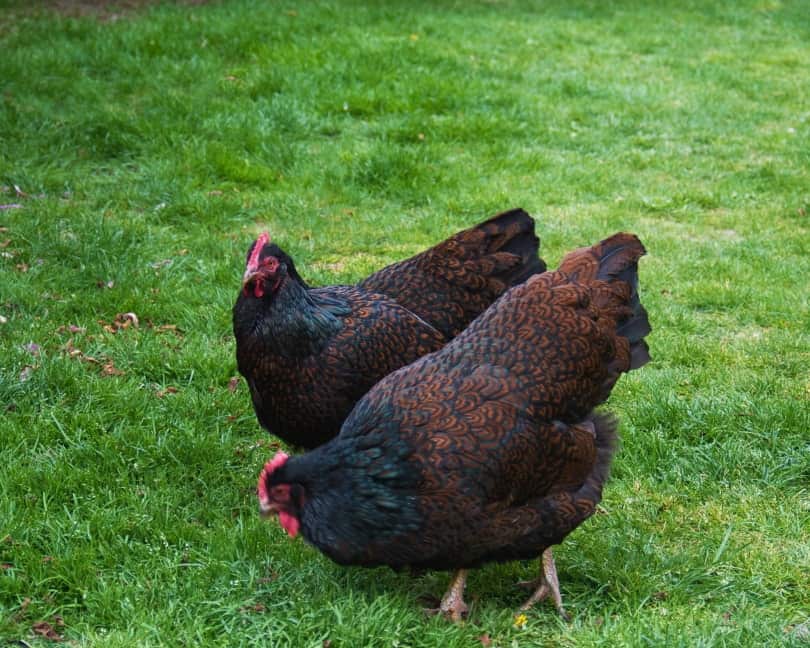
Weight: 6 – 9 lbs.
Appearance: The Barnevelder looks slim and agile. It has yellow legs and feet. Hens have a unique brown feather with double lacing that gives an arrowhead.
Temperament: Docile and friendly, the Barnevelder is considered a good breed for children to raise.
Egg Production: The Barnevelder will lay up to 200 eggs a year. The eggs are dark chocolate and can be speckled.
9. Leghorn Chickens
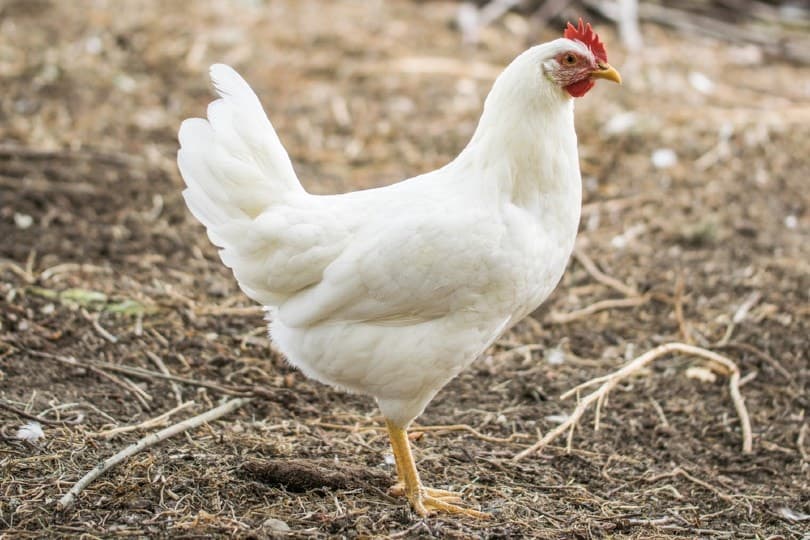
Weight: 5 – 8 lbs.
Appearance: The aerodynamic Leghorn has yellow skin and legs. Different varieties come in different colors, including the popular White Leghorn and Cream Leghorn variants.
Temperament: The intelligent Leghorn can find most of its own food if left to free-range. They will remain active and busy and are good at flying.
Egg Production: The Leghorn produces around 280 eggs a year. Eggs get bigger each year, are white and can be extra-large during her final years of laying.
- Also See: 16 German Chicken Breeds (with Pictures)
10. Easter Egger Chickens
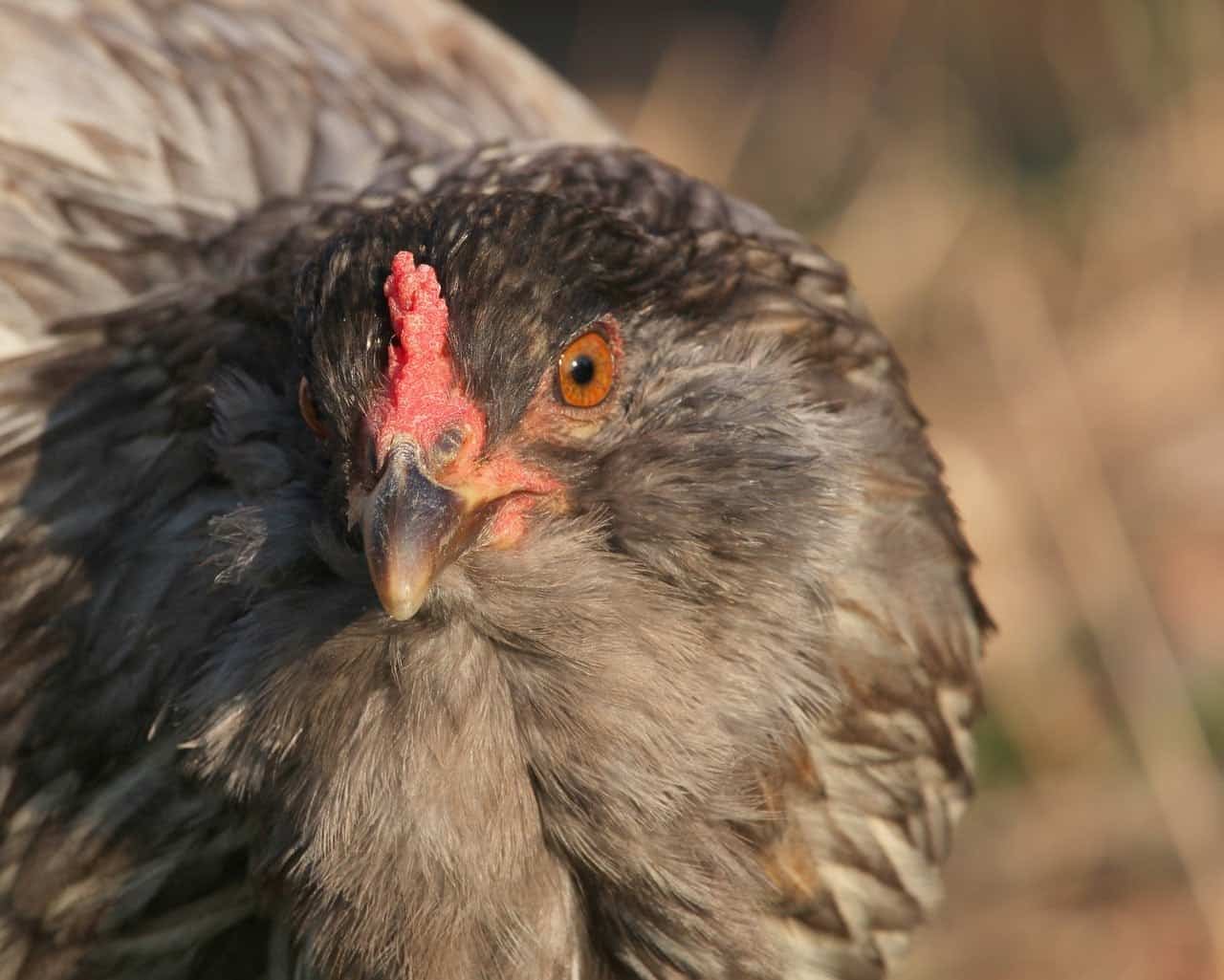
Weight: 3 – 6 lbs.
Appearance: The Easter Egger is a hybrid breed, but hybrids can make the best pets. Usually small, the Easter Egger will take on the appearance of its parents.
Temperament: The Easter Egger is usually friendly and sweet. They like treats and can sit in your lap. They are a good choice for family homes.
Egg Production: Producing approximately 200 a year, the Easter Egger can lay eggs in any one of a rainbow of colors, which is another reason for their popularity.
11. Silkies
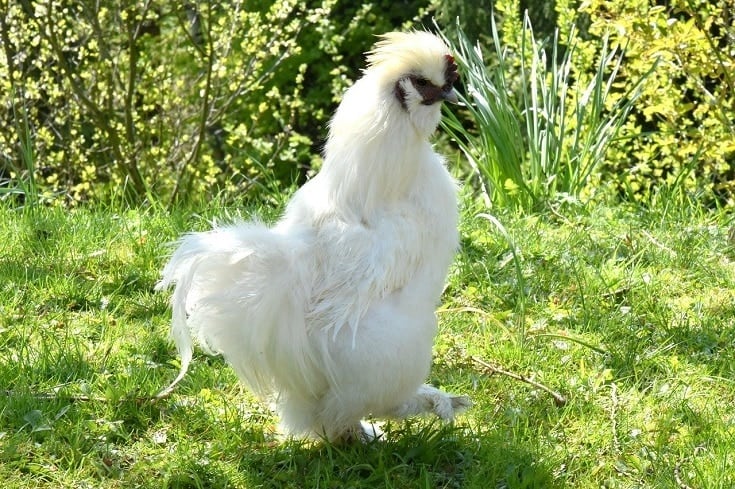
Weight: 2 – 4 lbs.
Appearance: Silkies are very small chickens that are covered from head to toe in soft feathers. Usually white, some Silkies have a beard while others do not. They have five, rather than four, toes on each foot.
Temperament: Described as calm and docile, even the roosters are known for being friendly little animals. They can make a great addition to a home coop.
Egg Production: The Silkie is not a prolific layer, producing around 100 eggs a year. The eggs are a cream color and are considered small in size.
12. Welsummer Chicken

Weight: 5 – 7 lbs.
Appearance: The stocky Welsummer has a large tail and is usually brown in color with a gold looking neck and upper body.
Temperament: The Welsummer is friendly and easy to handle. He likes being free-range and is considered a decent chicken for family coops.
Egg Production: The breed is sought after for its large, dark brown eggs, and you can expect up to 200 a year from this breed.
13. Wyandotte Chickens
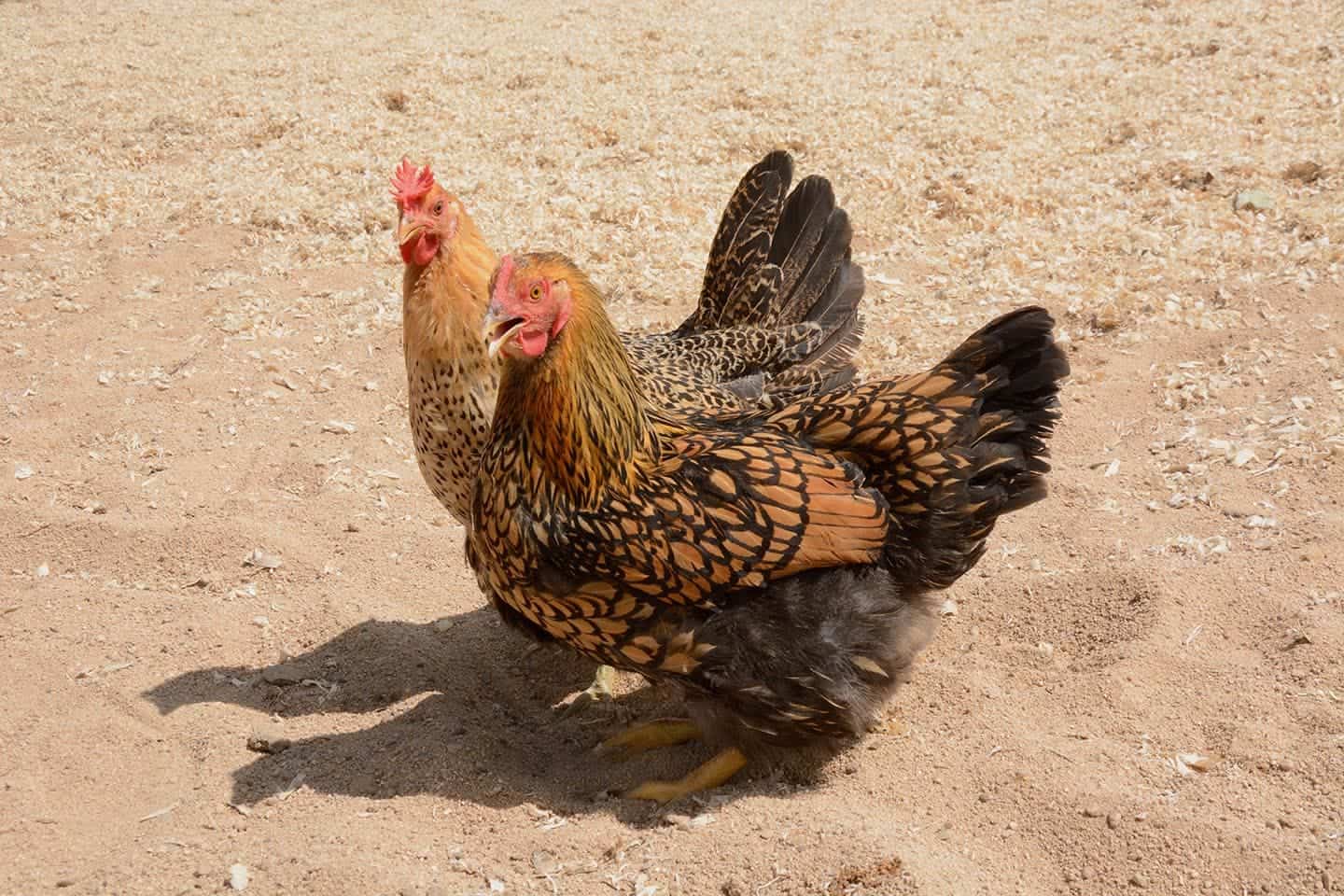
Weight: 6 – 10 lbs.
Appearance: The Wyandotte is a large bird that comes in different color varieties. It is a popular show breed, and while it is easy to find this breed, it can prove more difficult if you want show quality birds.
Temperament: Described as docile and friendly, the Wyandotte is a good choice of backyard bird.
Egg Production: You should get around 200, large brown eggs, a year, from your Wyandotte.
14. Speckled Sussex Chicken
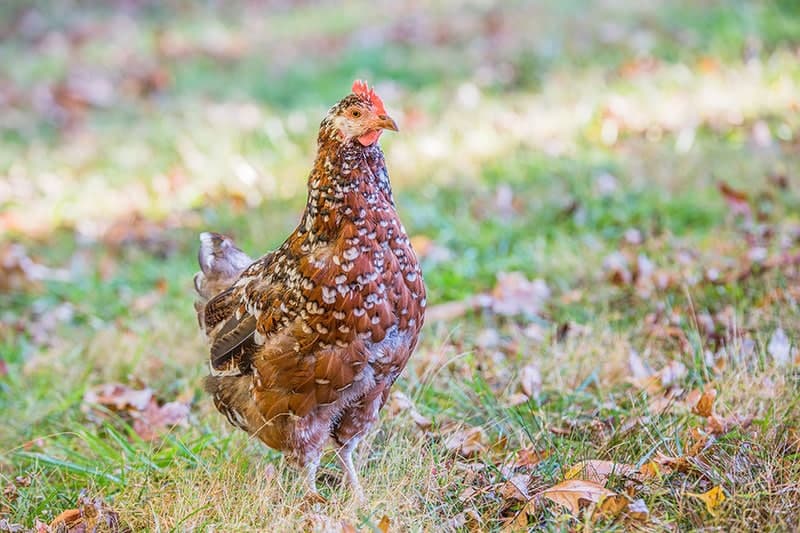
Weight: 6 – 10 lbs.
Appearance: Another large breed, the Sussex is a graceful chicken with wide shoulders. Colors include red, speckled, brown, and silver.
Temperament: These are docile but happy and friendly birds. They will follow you around, usually I the hope of betting some treats.
Egg Production: You should get between 200 and 250 eggs a year, including during winter. Eggs are large and brown.
15. Cochin
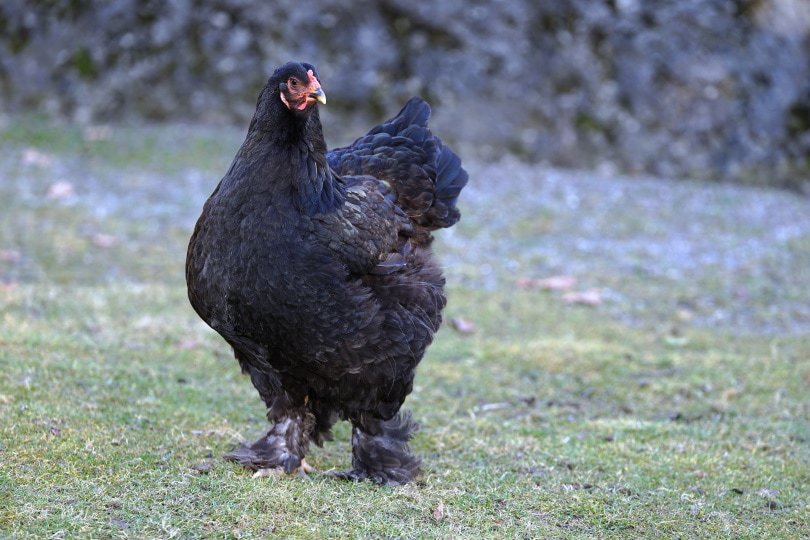
Weight: 8 – 11 lbs.
Appearance: The Cochin is a large breed and it looks even larger thanks to fluffy feathers from top to bottom. The length of their feathers means feet and legs should be hidden.
Temperament: Calm and friendly, the Cochin is a well-rounded bird that will do well in a backyard coop.
Egg Production: Although this breed unusually prefers to lay during winter, they are not prolific layers, giving around 180 small to medium brown eggs a year.
16. Polish Chicken
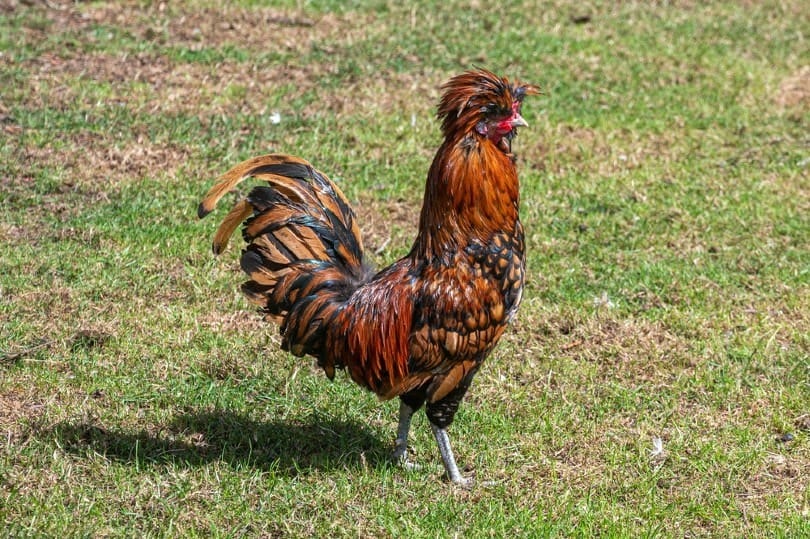
Weight: 4 – 7 lbs.
Appearance: The Polish is a small chicken, popular for its unique appearance. It has a prominent head crest of feathers that make it stand out from any other breed.
Temperament: Considered a calm chicken, the Polish can be inquisitive. They can be nervous, so you should whistle or talk to alert them to your approaching presence.
Egg Production: The Polish chicken will lay around 180 white eggs every year so are not considered a prolific layer.
17. Brahma Chickens
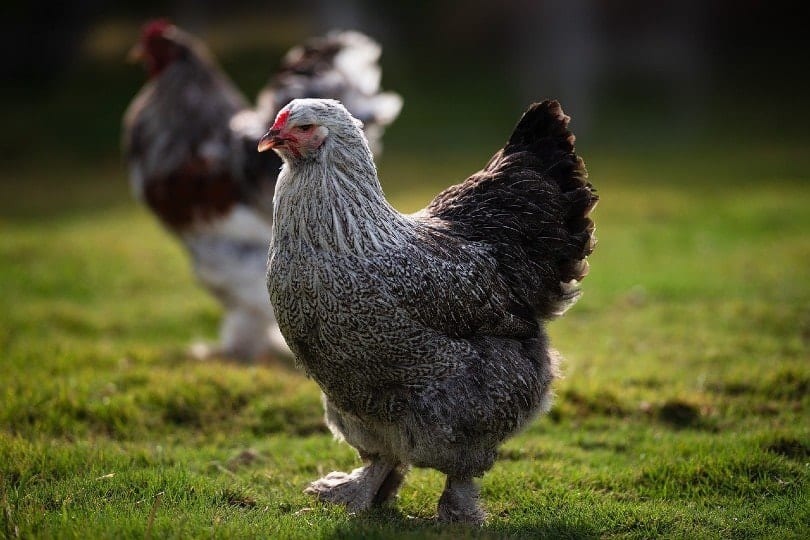
Weight: 7 – 12 lbs.
Appearance: All Brahma chickens have red eyes and a single pea comb, though they come in a variety of colors. You’ll sometimes hear Brahmas called the king of chickens due to their massive size. Hens often reach weights of up to 9 pounds while roosters are rarely less than 10 pounds and commonly as heavy as 12 pounds!
Temperament: The roosters are rather gentle, making them easy to handle, which is why these chickens can even make good pets. The extra weight they carry prevents them from flying, so a 2-foot fence is all that’s needed to house these chickens.
Egg Production: Because of their massive size, Brahma chickens are usually raised for their meat, though Brahma hens are still proficient egg layers at approximately 150 eggs per year.
18. Jersey Giant Chicken
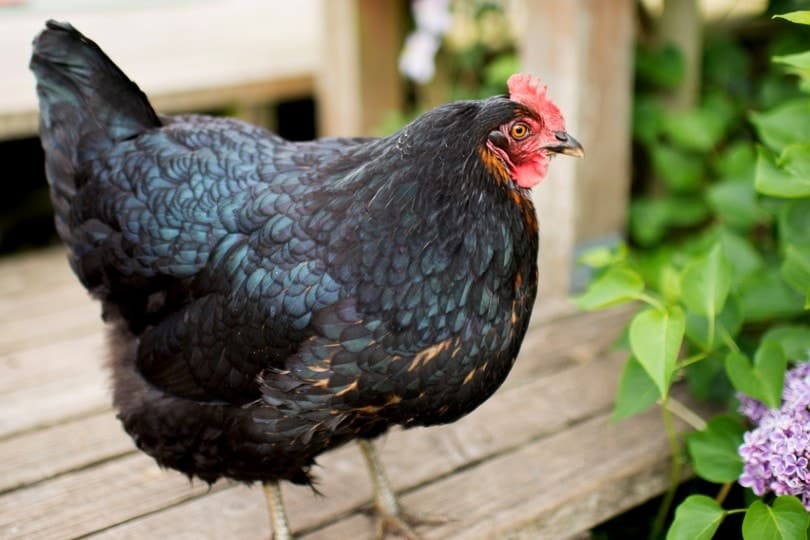
Weight: 9 – 15 lbs.
Appearance: The Jersey Giant definitely earned its name through its massive size. Even larger than the Brahma breed, which is called the king of chickens, Jersey Giants can reach weights of up to 15 pounds! In fact, they might be the largest breed of chickens in the world.
Temperament: First created in the US, Jersey Giants can offer more than just a gargantuan size. They’re also very gentle and easy to keep, which is a major reason for their popularity, which has grown to match their large stature.
Egg Production: They lay quite a few eggs yearly, averaging about 150 – 200 per year. Unfortunately, if hens go broody, they tend to break many of their eggs due to their large size.
19. Ameraucana Chicken
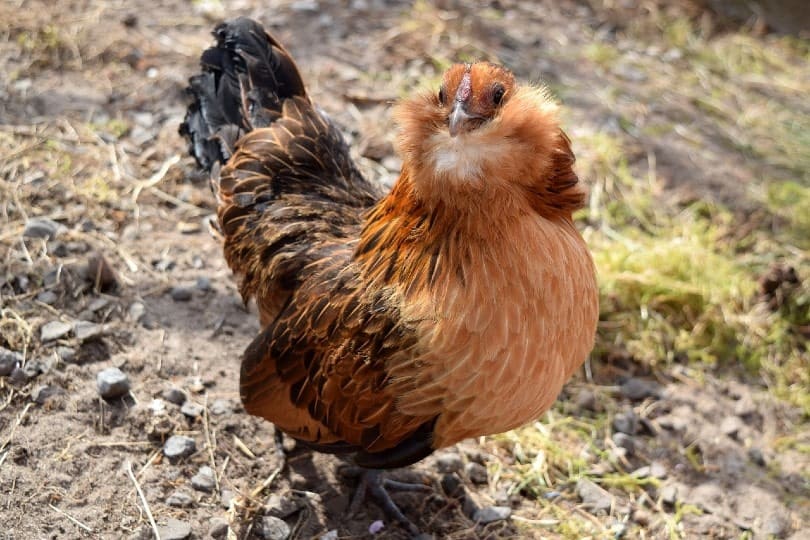
Weight: 5.5 – 6.5 lbs.
Appearance: Ameraucana chickens are often confused with Easter Eggers. They do look rather similar, but Ameraucanas are a pure breed with some unique characteristics. You can get Ameraucanas in eight different colors, including wheaten, white, blue, and silver. Don’t expect them to get very large, though. Males average about 6.5 pounds and females just 5.5 pounds.
Temperament: These birds are considered to be predator savvy, so if you let your chickens free-range, Ameraucanas are probably a good choice. They’re rather tolerant of the cold but don’t do very well in the heat.
Egg Production: They lay blue eggs! Their eggs are medium-sized, but you’ll get about 150 eggs per year. However, they’re slow to mature, so don’t expect your Ameraucana hens to start laying right away.
20. Turken (Naked Neck)
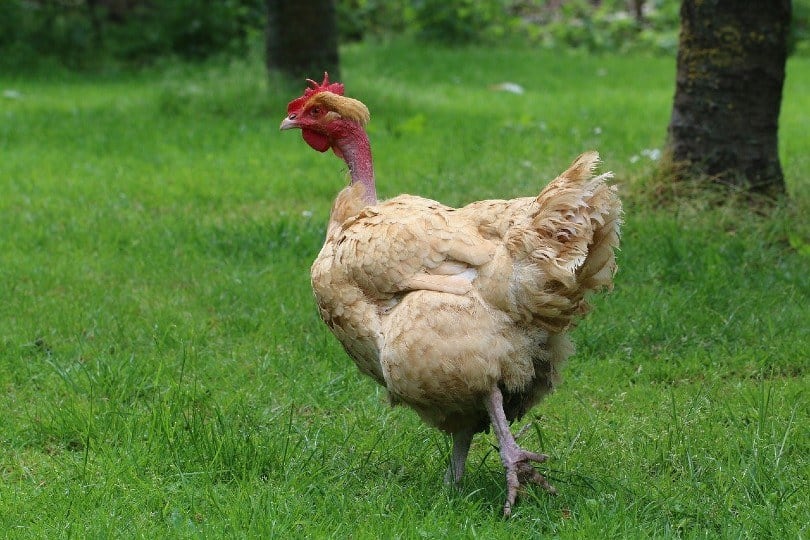
Weight: 5 – 7 lbs.
Appearance: If you’re looking for chickens that are as beautiful as they are productive, you might want to skip over the Turken. Also known as the naked neck chicken, these are some of the most unique looking chickens around. Generally speaking, missing feathers is a sign of illness. But Turkens have about half as many feathers as other chickens, which makes it look like they’re ill. They also have naked necks, with bare, wrinkled skin exposed. It’s an odd look. But nothing is wrong with this bird; that’s the way they’re bred!
Temperament: They’re suitable in both cold and hot weather conditions and tend to have calm and friendly personalities.
Egg Production: Approximately 100 large brown eggs per year.
21. Frizzle Chicken

Weight: 6 – 8 lbs.
Appearance: If you’ve never seen or heard of a Frizzle chicken before, you’ll probably be surprised to find out that they’ve been around since the 1600s! These birds are so-named for their frizzled appearance, with soft feathers that jut out in every direction. They’re somewhat similar to Silkies in appearance. But what’s really funny is that if you cross the two breeds, the resulting offspring is called a Sizzle!
Temperament: These birds are hardy but sweet. Because of their interesting feathering, Frizzles can’t fly. If you allow yours to free-range, you’ll need to provide ample protection from predators. They’re also not the most weather-averse chickens for the same reason, so they’re best suited for moderate climates.
Egg Production: The Frizzle hens lay around 180 – 200 eggs per year.
- See Also: Pekin Chicken
22. New Hampshire Red Chickens
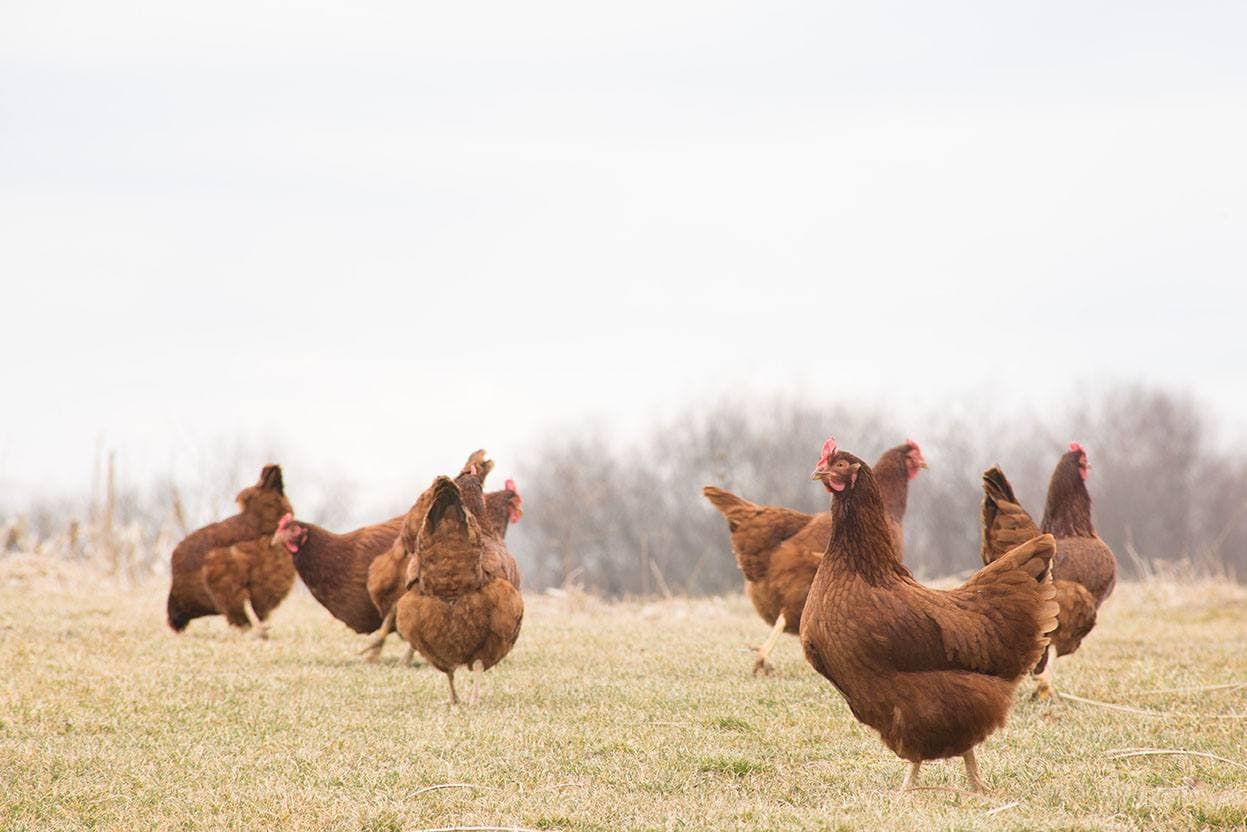
Weight: 7 – 9 lbs.
Appearance: New Hampshire Red chickens were first created as an off-shoot of the very popular Rhode Island Red breed. Today, they’re considered to be an entirely separate breed with several desirable characteristics. For instance, the New Hampshire Red offers considerably more meat than a Rhode Island Red, though the latter is a more prolific layer.
Temperament: These birds tend to have varied personalities, while some can be a bit aggressive, others are incredibly calm and friendly.
Egg Production: Hens can still produce about 200 eggs per year. Though they’re considered a dual-purpose breed, New Hampshire Reds are generally raised primarily for their meat.

Benefits of Housing Chickens in Your Backyard
- Keeping chickens in your yard gives you access to a regular supply of fresh chickens. Expect an average of 150 to 200 eggs a year, but you can get as many as 300 or as few as 100.
- Chickens make excellent fertilizer. Their manure is a good combination of nitrogen, phosphorous, and potassium that will benefit your plants and save you money.
- Some chickens are very affectionate and sweet and can even be trained to eat from your hand. They make surprisingly good pets with unique and individual characters.
- They will eat leftover salad, vegetables, fruit, rice, and nuts, making them great waste disposal. They will also clear your yard of bugs and insects like slugs and snails.
For all of the benefits, though, keeping chickens does have some drawbacks:
- They can be noisy. They chatter and make a series of noises. Some people love the noise, others less so.
- They poo a lot. The fertilizer is great, but it has to come from somewhere, and it is likely that your chickens will produce more poop than you can use.
- They do require care. Many homesteaders love chickens because they’re easier to maintain than other forms of livestock, but they do require daily maintenance and ongoing care.

How Much Room Do Chickens Need?
As a general rule, the more room you can give your chickens, the better, but you should provide approximately 3 square feet of indoor space and 10 square feet of outdoor space, per chicken. This ensures that your flock has enough room. If your birds do not have enough space, they will be prone to attacking one another and they may suffer stress, cannibalism, and pecking. The exact amount of space depends on the types of chicken breeds you raise. Smaller chickens do require less space, while those that prefer to free-range will prefer greater outdoor space and will enjoy being allowed to roam around the yard.
Considering Your Climate
Different chickens were bred in different countries and climates, and they usually prefer the type of climate they are accustomed to. Wyandottes do well in cold conditions, for example, while other birds prefer the heat. Many hens will not lay eggs during the winter months, but your climate should be one of the first and most important deciding factors when choosing a chicken breed.
- You may also find this interesting: 18 Friendliest Chicken Breeds

Final Thoughts
Choosing the right types of chicken breeds for your backyard coop means finding one that matches your requirements and desire to get a chicken. It should also be suitable for your climate and conditions, and because it is going to live in your yard, you will likely want a chicken that is friendly and docile.
There are many types of chickens for you to choose from. The 22 chicken breeds we’ve just covered are some of the most common and popular. Each of them offers some traits that make them desirable for certain keepers or situations. Whether you’re raising chickens for eggs, meat, or just to keep as pets, you’ll find a breed to suit your needs somewhere on this list.
Related read:
- Are Chickens Mammals or Birds?
- 100+ Funny Chicken Names: Ideas for Silly & Comical Chickens
- Ameraucana Chicken
- Kuroiler Chicken
Featured Image Credit: LMIMAGES, Shutterstock
